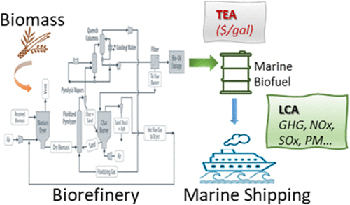Forget IMO 2020 — shippers’ decarbonization discussions are now focused on IMO 2050.
 The former phrase should be familiar to anyone who’s been tracking fuel market movements over the past few years. The latest emission limits by the International Maritime Organization (IMO), which went into effect in 2020 (hence “IMO 2020”), cap the sulfur oxide content of ships’ fuel oil at 0.5 percent or 5,000 parts per million, down from the previous limit of 3.5 percent or 35,000 parts per million. But IMO isn’t stopping there.
The former phrase should be familiar to anyone who’s been tracking fuel market movements over the past few years. The latest emission limits by the International Maritime Organization (IMO), which went into effect in 2020 (hence “IMO 2020”), cap the sulfur oxide content of ships’ fuel oil at 0.5 percent or 5,000 parts per million, down from the previous limit of 3.5 percent or 35,000 parts per million. But IMO isn’t stopping there.
By 2050, the organization aims to reduce greenhouse gas (GHG) emissions from international shipping by 50 percent compared to 2008 levels. It’s an aggressive target for an industry that still runs primarily on heavy fuel oil (HFO), albeit a lower-sulfur version. HFO is a viscous, black substance that a layperson might mistake for tar.
In response to IMO 2050 and a growing global movement to reduce marine shipping’s GHG emissions, the National Renewable Energy Laboratory (NREL) and other Department of Energy facilities are now investigating the potential use of several different kinds of marine biofuels. If the findings of these investigations prove to be as commercially viable as researchers expect, then the marine shipping industry may soon be able to turn to biofuels for emission reductions, just as the on-road transportation and aviation sectors are doing.
“Biofuels turned out to be very good options because they have zero or very, very low sulfur compared to fossil fuels,” said Eric Tan, a senior research engineer at NREL and lead author of a new article published in the journal Environmental Science and Technology.
The article, “Biofuel Options for Marine Applications: Techno-Economic and Life-Cycle Analysis” explores three potential production pathways for marine biofuels:
- “Fischer–Tropsch diesel from biomass and cofeeding biomass with natural gas or coal,
- renewable diesel via hydroprocessed esters and fatty acids from yellow grease and cofeeding yellow grease with heavy oil, and
- bio-oil via fast pyrolysis of low-ash woody feedstock.”
Researchers found that these marine biofuels could reduce emissions by 40 to 93 percent compared to heavy fuel oil. Additionally, the fuels are mostly sulfur free and demonstrate significant reductions in criteria air pollutant emissions including particulate matter.
According to NREL, “Tan’s research concluded that, if shipping had no competition, the United States has a large supply of bio-feedstocks for producing substantial amounts of marine biofuels to displace fossil fuels.” Of course, that’s a huge “if,” especially considering that at least one of the marine biofuels considered in this study — renewable diesel from yellow grease — is currently one of the most in-demand advanced biofuels in the U.S. Last year alone, yellow grease a.k.a. used cooking oil reduced carbon emissions by some 2.12 million metric tons under California’s Low-Carbon Fuel Standard (see “CARB Releases Latest LCFS Numbers”).
Nevertheless, with companies under increasing pressure to achieve emission reductions, some shippers are already finding ways to adopt marine biofuels. As touched on in an earlier energy.ink article, DHL Global Forwarding is evaluating waste-based biofuels that could replace HFO at no extra cost to the consumer (see “Combing the Coalition” from issue 4). “Sustainable fuel solutions are a key lever to change the fuel mix and reduce carbon emissions in ocean freight,” said Tim Scharwath, CEO, DHL Global Forwarding, Freight.
The sentiment echoes across roads, airways and now seas too.
